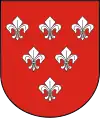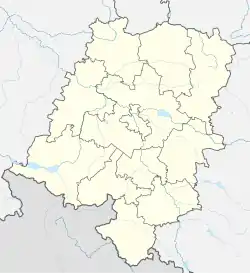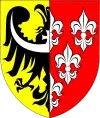Nysa, Poland
Nysa [ˈnɨsa] (![]() listen) (German: Neisse or Neiße) is a town in southwestern Poland on the Eastern Neisse (Polish: Nysa Kłodzka) river, situated in the Opole Voivodeship. With 43,849 inhabitants (2019), it is the capital of Nysa County. It comprises the urban portion of the surrounding Gmina Nysa. Historically the town was part of Lower Silesia.
listen) (German: Neisse or Neiße) is a town in southwestern Poland on the Eastern Neisse (Polish: Nysa Kłodzka) river, situated in the Opole Voivodeship. With 43,849 inhabitants (2019), it is the capital of Nysa County. It comprises the urban portion of the surrounding Gmina Nysa. Historically the town was part of Lower Silesia.
Nysa | |
|---|---|
 Main Square | |
 Flag  Coat of arms | |
| Nickname(s): Śląski Rzym Silesian Rome | |
 Nysa  Nysa | |
| Coordinates: 50°28′17″N 17°20′2″E | |
| Country | |
| Voivodeship | Opole |
| County | Nysa |
| Gmina | Nysa |
| Established | 10th century |
| Town rights | 1223 |
| Government | |
| • Mayor | Kordian Kolbiarz |
| Area | |
| • Total | 27.5 km2 (10.6 sq mi) |
| Elevation | 195 m (640 ft) |
| Population (2019-06-30[1]) | |
| • Total | 43,849 |
| • Density | 1,600/km2 (4,100/sq mi) |
| Time zone | UTC+1 (CET) |
| • Summer (DST) | UTC+2 (CEST) |
| Postal code | 48-300 |
| Area code(s) | +48 77 |
| Car plates | ONY |
| Website | http://www.nysa.pl |
History
Nysa is one of the oldest towns in Silesia. It was probably founded in the 10th century. The name of the Nysa river, from which the town takes its name, was mentioned in 991, when it was part of the Duchy of Poland under Mieszko I of Poland. A Polish stronghold was built in Nysa in the 11th and 12th century due to the proximity of the border with the Czech Duchy. As a result of the fragmentation of Poland, it became part of the Duchy of Silesia and from the 14th century it was the capital of the Duchy of Nysa, administered by the Bishopric of Wrocław. In the 12th the Gothic Basilica of St. James and St. Agnes was built, later rebuilt after the war devastations of the 13th and 14th centuries. Now designated a Historic Monument of Poland, it is the most distinctive and most valuable landmark of Nysa. Nysa was granted town rights around 1223 by bishop Lawrence, confirmed by Bolesław II Rogatka in 1250, and attracted Flemish and German settlers. In 1241 it was ravaged by the Mongols during the first Mongol invasion of Poland.[2] In 1245, it was granted staple right and two yearly fairs were established. In the early 14th century Nysa became an important trade and craft center of Poland, before it passed under the suzerainty of the Bohemian Crown in 1351,[2] under which it remained until 1742. It also became one of the leading cultural centers of Silesia.[3]

The town's fortifications from 1350 served to defend against the Hussites in 1424. During the Hussite Wars, in 1428 it was the site of the Battle of Nysa, with Poles and Czechs fighting on both sides.[2] One of the prominent signs that Nysa was a significant center, is the report in Nuremberg Chronicle, published in 1493, which mentions the city among the major urban centers of Central and Eastern Europe. In the description of the town population included in this chronicle we read "plebs rustica polonici ydeomatis ...". Other evidence is Nysa coat of arms at the entrance of the Charles Bridge in Prague, which is displayed alongside the arms of the most prominent Bohemian cities. In the 16th century it was a Polish printing center.[3]
During the Thirty Years' War (1618–1648) it was besieged three times. It was plundered by the Saxons and Swedes.[2] Polish prince and later King Władysław IV Vasa visited the town several times between 1619 and 1638. In 1624 the Kolegium Carolinum Neisse (today's I Liceum Ogólnokształcące), one of the most renown schools of Silesia, was established as a Jesuit college.[3] Polish King Michał Korybut Wiśniowiecki[4] and Polish prince James Louis Sobieski both attended the school.

During the First Silesian War (War of the Austrian Succession), in 1741 it was besieged and captured by Prussians,[2] King Frederick II of Prussia laid the foundations of its modern fortifications. In 1758 it was besieged by the Austrians.[2] On 25 August 1769 it was the site of a meeting between Frederick II and Emperor Joseph II, co-regent in the Habsburg Monarchy of Austria.
During the Napoleonic Wars, Neisse was taken by the French in 1807. It retained its mostly Catholic character within the predominantly Protestant province of Silesia in the Kingdom of Prussia. Because of its many churches from the Gothic and Baroque periods the town was nicknamed "the Silesian Rome". In 1816–1911, the town was the seat of the Neisse District, after which it became an independent city. According to the Prussian census of 1910, the city of Neisse had a population of 25,938, of whom around 95% spoke German, 4% spoke Polish and 1% were bilingual.[5]
During World War I and the post-war Polish Silesian Uprising, a prisoner-of-war camp was located in the town.[2] Charles de Gaulle, future leader of French Resistance against German occupation in World War II and later president of France, was imprisoned there in 1916. After World War I, Neisse became part of the new Province of Upper Silesia.
During World War II the Germans established a subcamp of the Gross-Rosen concentration camp, three forced labour camps,[3] and several working parties of the Stalag VIII-B/344 prisoner-of-war camp at Łambinowice.[6] Conquered by the Red Army in the last months of the war, the town was placed preliminarily under Polish administration according to the Potsdam Agreement and renamed to the Polish Nysa. The town's German population was partly evacuated. After the German defeat, following the preliminary establishment of the Oder-Neisse line as the new German-Polish border, the remaining German population of Nysa was expelled. Expulsions started in mid June 1945 by the Soviet-organized Polish militia surrounding settlements, entering homes, asking their inhabitants to leave their home with them.[7]
In the following years, new Polish settlers, some whom were themselves expelled or resettled from what is now Western Ukraine (see: Kresy), made Nysa their new home.
Nysa's monuments
As a result of destruction during World War II, in particular the heavy fighting of the Vistula–Oder Offensive of early 1945, during which the Red Army pushed the German Army Group A out of southwest Poland, the historic aspect of the town has only partially been preserved. The most important monuments have been rebuilt. A list of the monuments of Nysa is seen on the page Nysa's monuments.
Polish troops were stationed in Nysa until 2001, when they were relocated to Kłodzko.[2]
Economy

Until recently, Nysa was a major industrial centre in the Opole Voivodeship. The town was home to metal works, machinery production, agricultural produce and construction materials. The year 2002 saw the closure of the ZSD company. The company constructed delivery vehicles, namely the ZSD Nysa, FSO Polonez and, until recently, the Citroën C15 and Berlingo. Currently, the factory remains closed.
Recently, the Wałbrzych Special Economic Zone[8] is located by Dubois Street (ul. Dubois) and Krapacka Street (ul. Krapacka), largely revolving around agricultural goods and produce, as well as metal works.[9]
Sports
- Stal Nysa SA – men's volleyball team playing in Polish Volleyball League (Polska Liga Siatkówki, PLS), new in 2020 season.
- KŻ Nysa – sailing club with seat on Nysa's lake.
- AZS PWSZ Nysa - students club of AZS
- Polonia Nysa- football club.
Notable people




- Konrad Emil Bloch (1912–2000), biochemist
- Emanuel Sperner (1905-1980), German mathematician
- Marcin Bors (b. 1978), record producer
- Hans-Joachim Caesar, Reichsbank director, German bank comptroller in occupied France, 1940–44
- Emanuel Oscar Menahem Deutsch (1829–1873), scholar on the Middle East
- Rudolf Fränkel (1901–1974), architect
- Sigismund Freyer (1881-1944), German horse rider
- Piotr Gacek (b. 1978), volleyball player
- Bernhard Grzimek (1909–1987), zoologist and conservationist
- Wilhelm Hasse (1894–1945), Wehrmacht general
- Martin Helwig (1516–1574), cartographer
- Max Hodann (1894–1946), German physician
- Carl Hoffmann (1885–1947), German cinematographer and film director
- Jakub Jarosz (b. 1987), Polish volleyball player
- Valentin Krautwald (1465–1545), German religious reformer
- Edmund Lesser (1852–1918), German dermatologist
- Maria Merkert (1817–1872), founder of the Congregation of Saint Elizabeth
- Kurt von Morgen (1858–1928), Prussian explorer and officer
- Hans Guido Mutke (1921–2004), fighter pilot
- Emin Pasha (Eduard Schnitzer) (1840–1892), physician and Ottoman governor of Equatoria
- Karl-Georg Saebisch (1903–1984), German actor
- Solomon Schindler (1842–1915), rabbi
- Franz Skutsch (1865–1912), German classical philologist and linguist
- Max Ernst Wichura (1817–1866), German lawyer and botanist
- Arnold von Winckler (1856–1945), Prussian general
- Roman Wójcicki (b. 1958), footballer
Twin towns – sister cities
See also
| Wikimedia Commons has media related to Nysa. |
References
- "Population. Size and structure and vital statistics in Poland by territorial divison in 2019. As of 30th June". stat.gov.pl. Statistics Poland. 2019-10-15. Retrieved 2020-02-14.
- "Nyskie kalendarium militarne". Nasza Nysa (in Polish). Retrieved 14 March 2020.
- "Nysa". Encyklopedia PWN (in Polish). Retrieved 14 March 2020.
- "Michał (Michał Tomasz Korybut Wiśniowiecki)". Internetowy Polski Słownik Biograficzny (in Polish). Retrieved 14 March 2020.
- Belzyt, Leszek (1998). Sprachliche Minderheiten im preussischen Staat: 1815 - 1914 ; die preußische Sprachenstatistik in Bearbeitung und Kommentar. Marburg: Herder-Inst. ISBN 978-3-87969-267-5.
- "Working Parties". Stalag VIIIB 344 Lamsdorf. Retrieved 14 March 2020.
- Tragödie Schlesiens 1945&46 in Dokumenten (in German). Christ Unterwegs. 1952–1953. p. 227.
- "Home - WSSE Invest-Park. Wałbrzyska Specjalna Strefa Ekonomiczna Invest-Park". WSSE Invest-Park. Wałbrzyska Specjalna Strefa Ekonomiczna Invest-Park. Retrieved 30 January 2017.
- "Nysa » mapy, nieruchomości, GUS, szkoły, kody pocztowe, wynagrodzenie, bezrobocie, zarobki, edukacja, tabele". www.polskawliczbach.pl (in Polish). Retrieved 30 January 2017.
- "NEISSE BUCH DER ERINNERUNG", Dr. Max Warmbrunn & Alfred Jahn, Gedruckt bei Druckhaus Nürnberg GmbH, 1966
External links
- Map c1600 Neis(s)e in Silesia, Germany
- Jewish Community in Nysa on Virtual Shtetl



